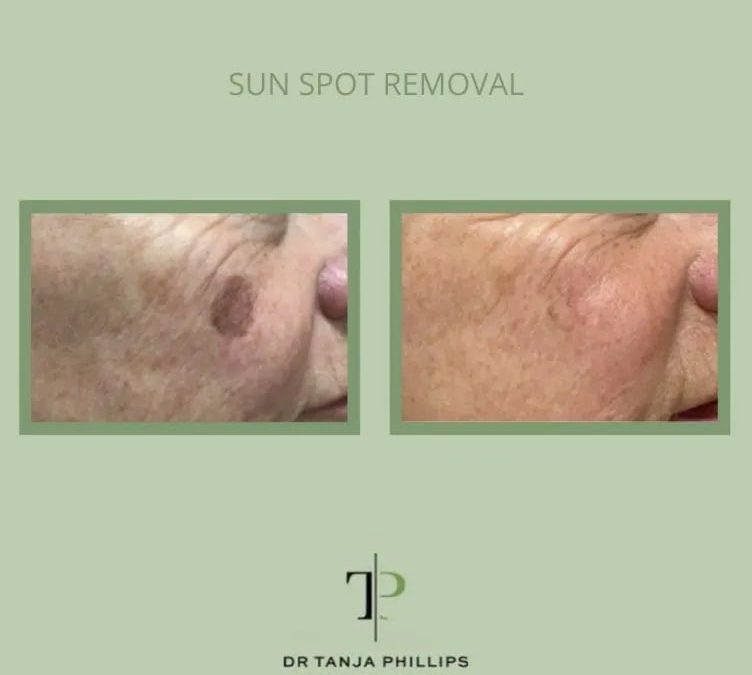
How to Get Rid of Skin Pigmentation
17/08/2025
Do Fat Dissolving Injections Work?
22/08/2025Age spots which are also known as sun spots or liver spots (medically identified as solar lentigines) show up as flat patches of darker pigment on skin areas exposed to sunlight such as the face or hands. The combination of UV exposure and natural skin ageing causes these spots to show up during middle age. People who have fair skin or spend a lot of time in the sun are more likely to develop age spots. Still, any new or changing spot should be checked by a dermatologist first aad.orgdermatologist.org.uk. In the skin, these spots lie deep in the top layer, so treatments must penetrate into that layer to reach the pigment mayoclinic.org. Solar lentigines is the medical term for these spots.
What Are Age Spots?
Age spots form when pigment-making cells (melanocytes) deposit extra melanin in patches due to sun exposure and ageing. As a UK dermatologist guide notes, many years of direct sunlight can “turn the skin… to a light or dark brown colour”. Young skin usually fades away minor sunspots but as time passes skin renewal slows down which causes brown patches to stay. Your genetic makeup determines part of your risk for developing age spots because you inherit this trait from your parents. The spots usually appear as flat oval shapes that measure between 5 to 10 millimeters in diameter and appear on the hands, face, chest or shoulders. Age spots are not painful and are simply a cosmetic issue. If you have any doubt about a spot (for example if it changes shape, colour or size) – see a dermatologist to rule out anything serious.
Sun Protection and Prevention
The most successful method for prevention requires complete sun protection. Every day before going outside you should apply sunscreen with broad-spectrum protection and at least SPF 30 value to all exposed skin parts and you need to apply it again every two hours when you are outside. You should wear protective clothing that includes a wide-brimmed hat along with long sleeves whenever the sun is at its strongest intensity. You should restrict your time outside during the middle of the day while completely refraining from using sunbeds. These protective behaviors help your skin stay safe from damage while decreasing the chances of treated spots coming back.
- Apply sunscreen SPF30+ daily and reapply every 2 hours
- Wear a wide-brimmed hat and long sleeves in the sun
- Seek shade during peak sun (around midday)
- Avoid tanning beds and indoor tanning
Creams and Home Remedies
Age spot fading creams which you can purchase at the store work at a gradual pace to reduce pigmentation. The fading creams use 2–4% hydroquinone or glycolic acid or kojic acid as their active ingredients to decrease pigmentation. The skin can become brighter through the application of Vitamin C and niacinamide serums. A medical provider will provide you with stronger treatment options through prescription hydroquinone creams together with tretinoin (Retin-A) and mild steroids. Use these treatments with caution by following the directions while applying them minimally and applying daily SPF protection. According to Mayo Clinic the fading of spots requires several weeks to months of regular application before it becomes noticeable. To prevent skin irritation you must use only one active treatment at a time.
Professional Treatments
- Cryotherapy (freezing): The application of liquid nitrogen through cryotherapy quickly eliminates spot pigmentation. After treatment the affected area develops blisters which lead to skin peeling that shows lighter pigmentation. Temporary redness and swelling may occur as side effects along with extremely uncommon cases of permanent pigmentation changes.
- Chemical Peels:A chemical solution is applied to peel off the top layer of skin. This causes new, smoother skin to form. The treatment requires multiple sessions because the skin remains red and flaky for several days after each session.
- Laser and IPL Therapy: The lasers work by targeting melanin pigments which leads to their fragmentation. A single or pair of laser or IPL sessions effectively eliminates spots at a faster rate than topical treatments. The treated spot will experience temporary darkening and crust formation before it heals. The Q-switched Nd:YAG laser operates through 2–3 sessions to achieve successful skin lightening.
- Dermabrasion / Microdermabrasion: The exfoliating methods work by eliminating the uppermost skin layers. Using a rotating brush in dermabrasion produces redness together with scabbing as its typical side effects. The fading of spots through dermabrasion or microdermabrasion treatments demands multiple sessions for optimal results.
- Downtime and Healing: Several days of redness together with swelling and peeling occur after most treatment procedures. Your doctor will give you instructions on post-treatment care through recommendations about moisturiser application and sun protection.
Doctors often combine treatments. For example, a dermatologist may follow a laser session with a mild chemical peel or prescribe a bleaching cream to speed up fading.
Lifestyle Tips and Expectations
- Use a gentle cleanser and daily moisturiser to keep skin healthy.
- Continue using SPF 30+ sunscreen every day to protect treated skin.
- Avoid picking or scratching spots to prevent scarring.
- Consider using concealer or foundation to hide spots while they fade.
- The treated spot will darken before shedding skin flakes during new skin regeneration.
The treated area will exhibit normal signs of redness along with swelling and peeling that requires moisturising while protecting it from sunlight until it heals. Age spots may disappear through treatment but they will likely return when you continue to expose your skin to the sun. Blocking UV rays can reduce the chance of spots coming back my.clevelandclinic.org.The fading spots can be hidden using concealer or tinted moisturiser products until they disappear. The complete removal of spots remains unlikely even though treatments can successfully diminish their appearance.
Professional Care with Dr. Tanja Phillips
Dr Tanja Phillips is a UK dermatologist and laser specialist. Her clinic uses advanced medical lasers (like the Fotona Starwalker) to target brown pigment precisely without harming normal skin. She also guides patients on prescription creams and skincare products that have proven ingredients. In a consultation with Dr Phillips you can expect a full skin assessment and a personalised treatment plan. More information and booking details are available on her clinic website (tanjaphillips.com). Taking all these steps, from daily sun care to medical treatments – often provides the best outcome. For specialist advice and treatment, you can consult Dr Phillips via her website.


